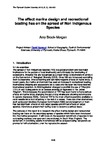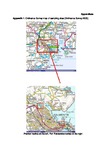The effect marina design and recreational boating has on the spread of Non Indigenous Species
| dc.contributor.author | Brock-Morgan, A. | |
| dc.date.accessioned | 2019-05-13T14:42:23Z | |
| dc.date.available | 2019-05-13T14:42:23Z | |
| dc.date.issued | 2010 | |
| dc.identifier.citation |
Brock-Morgan, A. (2010) 'The effect marina design and recreational boating has on the spread of Non Indigenous Species', The Plymouth Student Scientist, p. 163-206. | en_US |
| dc.identifier.issn | 1754-2383 | |
| dc.identifier.uri | http://hdl.handle.net/10026.1/13902 | |
| dc.description.abstract |
The spread of Non Indigenous Species (NIS) is a global problem and has major implications for the pattern of local biodiversity and ultimately the functioning of ecosystems. Invasive NIS are recognised as a major threat to biodiversity in article 8 on the Convention of Biological Diversity (CBD). Once NIS are introduced controlling them is expensive, time-consuming and can have negative effects on native biota. It recent years, the marine environment has seen an increase in recreational boating, international shipping and aquaculture but to date only the latter two have received international attention. In 2008 legislation changed to prohibit the use of Tributyltin (TBT) in anti fouling paints on all vessels entering or registered to the United Kingdom. This is because the accumulation of TBT has been found to have serious effects on marine biota; changing the sex of dog whelks and showing deformations in oysters (Savarese 2005). However TBT is the most effective pesticide available to deter sessile biota from attaching to the hull of a vessel. There are other alternatives, such as booster biocides (European Commission 2006) but development of them has had significant effects on non target species and limited effects on target species, therefore at present hull fouling is set to become a serious issue. The purpose of this report is to research the effect marina design and recreational boating can have on the secondary spread of species which have been introduced into the marine ecosystem. It will focus on the seasonal recruitment of species in two contrasting marinas, one open and one enclosed, in South West England. The settlement of colonising sessile invertebrates will be analysed using test panels as proxies for hull colonisation, over the reproductive season. | en_US |
| dc.language.iso | en | en_US |
| dc.publisher | University of Plymouth | |
| dc.rights | Attribution 3.0 United States | * |
| dc.rights.uri | http://creativecommons.org/licenses/by/3.0/us/ | * |
| dc.subject | Non Indigenous Species | en_US |
| dc.subject | global | en_US |
| dc.subject | NIS | en_US |
| dc.subject | marine environment | en_US |
| dc.subject | marine | en_US |
| dc.subject | Tributyltin | en_US |
| dc.subject | TBT | en_US |
| dc.subject | ecosystem | en_US |
| dc.subject | biodiversity | en_US |
| dc.subject | oysters | en_US |
| dc.subject | boating | en_US |
| dc.subject | recreational boating | en_US |
| dc.title | The effect marina design and recreational boating has on the spread of Non Indigenous Species | en_US |
| dc.type | Article | |
| plymouth.issue | 1 | |
| plymouth.volume | 3 | |
| plymouth.journal | The Plymouth Student Scientist |




